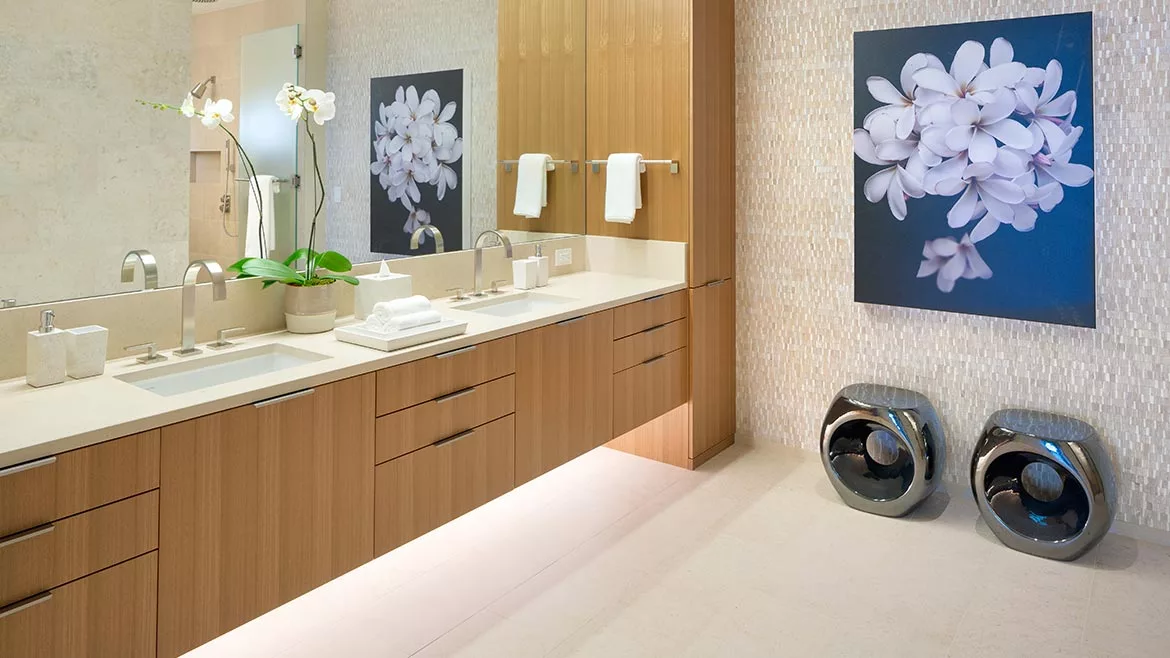How Properly Prepared Substrates Help to Avoid Failed Flooring Installations

Proper subfloor preparation created a successful installation parquet, stone slabs and tiles, textiles, resilient and rubber at the Park Lane Ala Moana in Honolulu, Hawaii.
Photo: Mapei
In today’s increasingly fast-paced construction environment, where time spent is money spent, successfully prepping substrates to ensure the successful installation of flooring is more critical than ever. The flooring installation industry’s track record in terms of proper substrate preparation, however, leaves something to be desired.
Floor Trends recently explored this issue with Gary Crowe, who is a territory business manager with Fishman Flooring Solutions in the company’s Mid-Atlantic Region, primarily covering Maryland, Northern Virginia, and the District of Columbia. Crowe has almost 30 years of experience in the building materials industry, half of it with Fishman, and is an expert on the proper preparation of flooring substrates.

Gary Crowe is a territory business manager with Fishman Flooring Solutions in the company’s Mid-Atlantic Region.
Photo: Fishman Flooring Solutions.
Floor Trends: Based on your experience, roughly what percentage of substrates today are properly prepped prior to the installation of flooring?
Crowe: In my estimation, currently about 75 percent of substrates are prepared correctly for flooring installations. To me, that number is not acceptable. When so many improperly prepped substrates lead to failed flooring installations, it gives the flooring installation industry a black eye and has serious repercussions in the marketplace.
Floor Trends: What are the financial consequences of these improperly prepared substrates for building owners, end users, flooring installation contractors, and others?
Crowe: Because there are so many failed flooring installations today, the cost of remediation could easily be a half a billion dollars or more annually. This includes the costs to repair and replace the failed flooring and loss of the use of the space while the repairs are being made.
Importantly, the cost is not only limited to dollars and cents. I think there is a lack of education and understanding in the marketplace regarding the health issues that can arise when vapor-driven moisture levels are above the tolerances of flooring products.
Floor Trends: Are there some fundamental reasons why so many subfloors are improperly prepped?
Crowe: For one thing, there can be reluctance on the part of general contractors to approve the expense of moisture remediation and the proper application of patch and self-levelers on substrates. I think many of these general contractors, as well as other decision makers, believe that certain floor coverings will accommodate imperfections in the substrate. Unfortunately, that is not always the case.
Finally, there are many flooring installation contractors who do not understand how to address moisture problems in a substrate completely and correctly and/or clean and remove old adhesives and other contaminants prior to a flooring installation. When these issues are in play, it can easily lead to failed flooring installations.
Floor Trends: How would you define a properly prepped substrate before an underlayment is used? What should it look like visually?
Crowe: Simply put, the substrate should be sound, flat to the flooring manufacturer’s specifications, clean, and have the required porosity to accept adhesive when glue-down floor coverings are used. Adhesives are formulated to bond to both the floor covering and a clean substrate, not to the old, dried adhesive.
Floor Trends: What are the products that are well suited to removing contaminants, such as old adhesive, grease, or oil, from a substrate? Why do they work?
Crowe: Sentinel Products offers a selection of environmentally-friendly adhesive removers specifically formulated to remove several types of flooring adhesive. Mapei’s Planiprep AR adhesive remover, when used in conjunction with their Planiprep SA scouring agent and ET epoxy treatment, does an outstanding job removing adhesive from larger projects.
Grease and oil can usually be cleaned with readily available products, such as Dawn Dishwashing Liquid. These products work because they remove bond breakers from the slab and ensure the proper adhesion of the new floor covering to it.
Floor Trends: What products would you recommend to address cracks in a substrate?
Crowe: Two that come to mind are Mapei Mapelastic CI and ARDEX 8+9. Both are liquid rubber membranes applied with a paint roller. These and other similar products prevent in-plane cracks in the substrate from transferring through tile, stone, and grouts.
Floor Trends: Will the type of substrate dictate which underlayment products to use or does one size fit all?
Crowe: While some products can be used over more than one type of substrate, they are not universal. It’s important for installers to read the manufacturer’s data sheet and ensure that the primer, patch, and self-leveling underlayment they intend to use are approved and warranted for the type of substrate on their projects.
Floor Trends: What is the best way for installers to keep pace with the number of newer, more advanced underlayment technologies being introduced today?
Crowe: It‘s all about installers continually taking the initiative to keep up with evolving technologies. The best floor covering installers regularly read publications like Floor Covering Installer and Floor Trends to learn how to do their jobs better. They talk to product manufacturers’ reps in the field about new products and take advantage of the technical services phone numbers and published data sheets that are available on manufacturers’ websites to learn about new products. The top installers also invest the time to attend professional training seminars at distributors like Fishman Flooring Solutions or at manufacturer’s locations. Product manufacturers and distributors are more than willing to help installers learn about new products and how to use them because they want installers to have nothing but success on their jobsites.
Floor Trends: How would you define a well-qualified flooring installation contractor?
Crowe: They’re easy to spot. They have professional relationships with manufacturer and supplier reps; keep themselves abreast of industry changes and innovations; and ensure that members of their teams are trained and educated. People hiring flooring installation contractors should not be shy about asking them for their credentials.
Floor Trends: What’s the most important piece of advice would you give installers, contractors, building owners, architects, and designers when it comes to properly using underlayment products to prep substrates?
Crowe: Never take shortcuts when prepping a substrate. Always ensure that the substrate meets the requirements of the new floor covering and always deal with problem areas while the substrate is exposed.
Looking for a reprint of this article?
From high-res PDFs to custom plaques, order your copy today!





